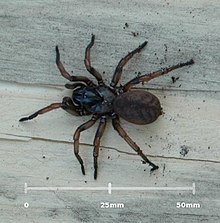Stanwellia
Appearance
| Stanwellia | |
|---|---|

| |
| Melbourne trapdoor spider (Stanwellia grisea) | |
| Scientific classification | |
| Domain: | Eukaryota |
| Kingdom: | Animalia |
| Phylum: | Arthropoda |
| Subphylum: | Chelicerata |
| Class: | Arachnida |
| Order: | Araneae |
| Infraorder: | Mygalomorphae |
| Family: | Pycnothelidae |
| Genus: | Stanwellia Rainbow & Pulleine, 1918[1] |
| Type species | |
| S. hoggi (Rainbow, 1914)
| |
| Species | |
|
18, see text | |
| Synonyms[1] | |
| |
Stanwellia is a genus of South Pacific mygalomorph spiders in the family Pycnothelidae. It was first described by W. J. Rainbow & R. H. Pulleine in 1918.[3] Originally placed with the curtain-web spiders,[3] it was transferred to the funnel-web trapdoor spiders in 1985,[4] then to the Pycnothelidae in 2020.[5] It is a senior synonym of Aparua.[2]
Species
[edit]
As of June 2020[update] the genus contained eighteen species, found in New Zealand (NZ) and the Australian states of New South Wales (NSW), Victoria (VIC), South Australia (SA) and Tasmania (TAS):[1]
- Stanwellia annulipes (C. L. Koch, 1841) – TAS
- Stanwellia bipectinata (Todd, 1945) – NZ
- Stanwellia grisea (Hogg, 1901) – VIC
- Stanwellia hapua (Forster, 1968) – NZ
- Stanwellia hoggi (Rainbow, 1914) (type) – NSW
- Stanwellia hollowayi (Forster, 1968) – NZ
- Stanwellia houhora (Forster, 1968) – NZ
- Stanwellia inornata Main, 1972 – VIC
- Stanwellia kaituna (Forster, 1968) – NZ
- Stanwellia media (Forster, 1968) – NZ
- Stanwellia minor (Kulczyński, 1908) – NSW
- Stanwellia nebulosa (Rainbow & Pulleine, 1918) – SA
- Stanwellia occidentalis Main, 1972 – SA
- Stanwellia pexa (Hickman, 1930) – TAS
- Stanwellia puna (Forster, 1968) – NZ
- Stanwellia regia (Forster, 1968) – NZ
- Stanwellia taranga (Forster, 1968) – NZ
- Stanwellia tuna (Forster, 1968) – NZ
See also
[edit]References
[edit]- ^ a b c "Gen. Stanwellia Rainbow & Pulleine, 1918". World Spider Catalog Version 20.0. Natural History Museum Bern. 2020. doi:10.24436/2. Retrieved 2020-07-11.
- ^ a b Main, B. Y. (1983). "Further studies on the systematics of Australian Diplurinae (Chelicerata: Mygalomorphae: Dipluridae): Two new genera from south Western Australia". Journal of Natural History. 17 (6): 923. doi:10.1080/00222938300770731.
- ^ a b Rainbow, W. J.; Pulleine, R. H. (1918). "Australian trap-door spiders". Records of the Australian Museum. 12 (7): 81–169. doi:10.3853/j.0067-1975.12.1918.882.
- ^ Raven, R. J. (1985). "The spider infraorder Mygalomorphae (Araneae): Cladistics and systematics". Bulletin of the American Museum of Natural History. 182: 82.
- ^ Opatova, V.; et al. (2020). "Phylogenetic systematics and evolution of the spider infraorder Mygalomorphae using genomic scale data". Systematic Biology. 69 (4): 701. doi:10.1093/sysbio/syz064. PMID 31841157.
Further reading
[edit]- Main, B. Y. (1972). "The mygalomorph spider genus Stanwellia Rainbow & Pulleine (Dipluridae) and its relationship to Aname Koch and certain other diplurine genera". Journal and Proceedings of the Royal Society of Western Australia. 55: 100–114.
- Forster, R. R. (1968). "The spiders of New Zealand. Part II. Ctenizidae, Dipluridae". Otago Museum Bulletin. 2: 126–180.
- Hogg, H. R. (1901). "On Australian and New Zealand spiders of the suborder Mygalomorphae". Proceedings of the Zoological Society of London. 71 (1): 218–279. doi:10.1111/j.1469-7998.1901.tb08176.x.
- Raven, R. J. (1981). "A review of the Australian genera of the mygalomorph spider subfamily Diplurinae (Dipluridae: Chelicerata)". Australian Journal of Zoology. 29 (3): 321–363. doi:10.1071/ZO9810321.
External links
[edit]- Melbourne Trapdoor spider
- Melbourne Trap-door Spider Stanwellia grisea
- Victorian Funnel web, Trap-door spiders and Mouse spiders. Which spiders do Victorians mistake for a Sydney Funnel-web?
